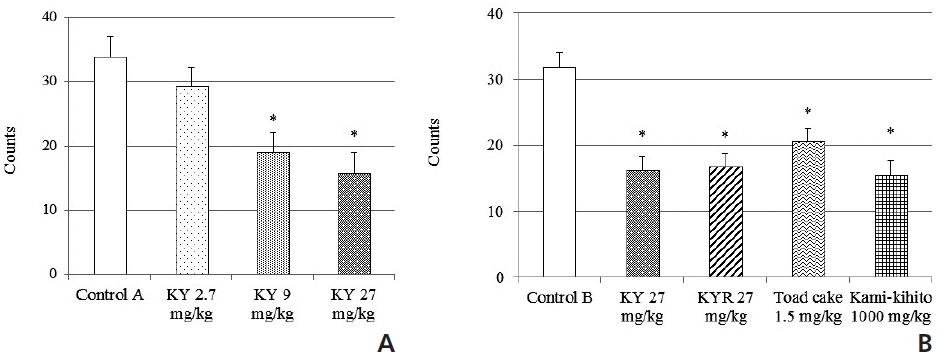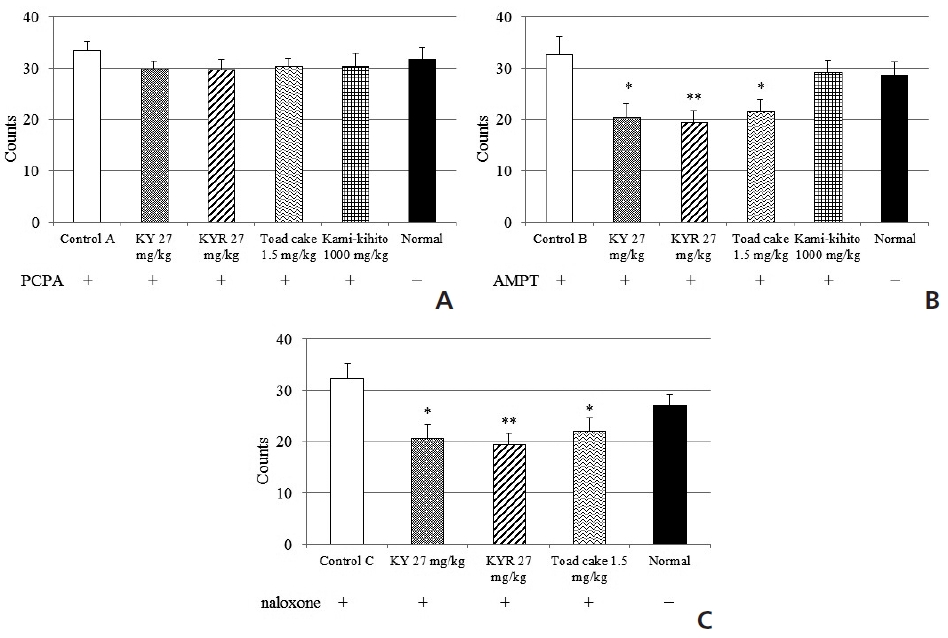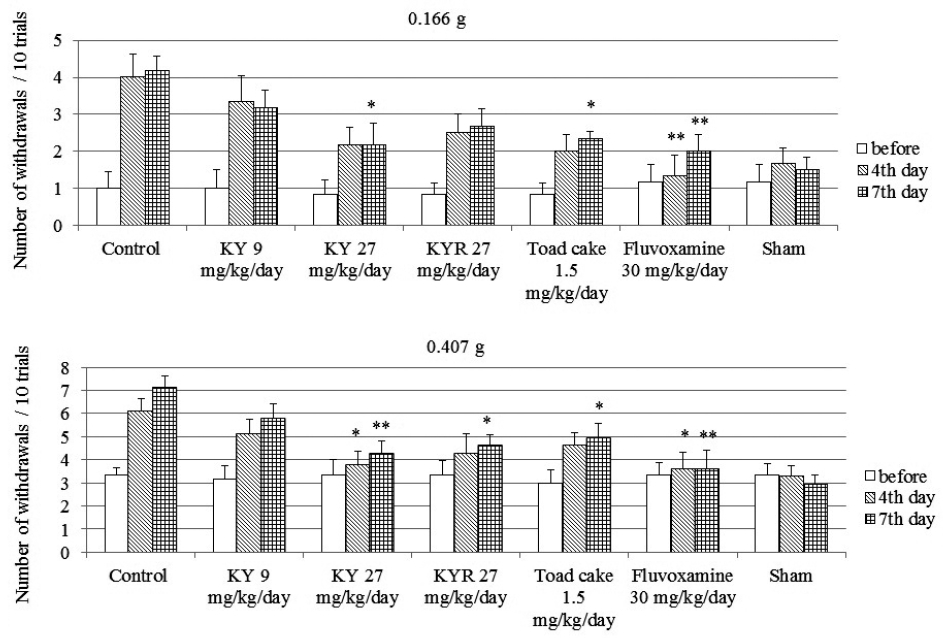Pain is a useful protective mechanism that warns the body of danger and is also important as a signal of organic change. However, in many cases, pain that develops pathologically is not useful and reduces the quality of life (QOL). Pain accompanying organic change can be divided into nociceptive pain and neuropathic pain [1]. Nociceptive pain is caused by stimulation of peripheral nociceptors, and is one of the most common types of pain. Recently, it has become possible to remove almost all types of nociceptive pain by using combinations of non-steroidal anti-inflammatory drugs (NSAIDs) and narcotic analgesics. Neuropathic pain is caused by pathophysiological injury to the central nerves or to the peripheral nerves and shows allodynia as one of its characteristic symptoms. Allodynia is pain due to a minute stimulus that does not normally provoke pain. Neuropathic pain is chronic intractable pain that is resistant to NSAIDs and narcotic analgesics, and its detailed pathological mechanism has not been investigated yet [2], so treatment of this pain has remained a clinical problem [3].
Toad cake (Ch’an Su) is the dried venom of the toad Bufo bufo gargarizans Cantor or Bufo melanostictus Schneider and has been used as an oriental drug for its cardiotonic, anti-inflammatory and analgesic effects since ancient times [4, 5]. In Japan, toad cake has been used as an ingredient of over-the-counter drugs such as Kyushin and Rokushin-gan, which have efficacy for palpitations and shortness of breath and as a restorative. Although the analgesic effect of toad cake and toad-cake-containing drugs [4, 6] has been reported, its effect on different types of pain and its mechanism of action have not been studied. Therefore, we examined the effects of toad cake and toad-cake-containing herbal drugs on the writhing response of mice as nociceptive pain model and on the withdrawal response of the hind paw of mice after partial ligation of the sciatic nerve as a neuropathic pain model, and we considered their mechanisms of action by using a co-treatment study with neurotransmitter synthesis inhibitors or opioid receptor blockers.
Five- or six-week-old male ddY mice were obtained from Japan SLC (Shizuoka, Japan) or JLA (Tokyo, Japan) and were used at six or seven weeks of age after an acclimatization period. All animals were maintained in a room with controlled temperature (22 ± 1℃) and humidity (55 ± 10%), along with a 12-hour light-dark cycle, and were allowed free access to standard lab chow and tap water. The experimental protocol was approved by the Animal Care and Use Committee of Kyushin Pharmaceutical Co., Ltd. Furthermore, the study protocol complied with the laws and notifications of the Japanese government prior to commencement of the study.
Two kinds of formulations of Kyushin [KY and KYR; Kyushin Pharmaceutical (Tokyo, Japan)] were used in this study. KY contains 5 mg of toad cake, 3 mg of bezoar, 25 mg of ginseng, 1 mg of musk, 6 mg of antelope horn, 8 mg of dried bile, 7.5 mg of pearl, 2.7 mg of borneol and 31.8 mg of fillers in a daily dose (90 mg). KYR contains 5 mg of toad cake, 3 mg of bezoar, 23 mg of ginseng, 5 mg of velvet horn, 6 mg of antelope horn, 6 mg of dried bile, 7.5 mg of pearl, 2.7 mg of borneol and 31.8 mg of fillers in a daily dose (90 mg). Toad cake was obtained from Kyushin Pharmaceutical. Fluvoxamine maleate was purchased from Wako Pure Chemicals (Osaka, Japan). Pentobarbital sodium was purchased from Tokyo Kasei Chemicals (Tokyo, Japan). 4-chloro-DL-phenylalanine methyl ester hydrochloride (PCPA) and α-methyl-DL-tyrosine methyl ester hydrochloride (AMPT) were purchased from Sigma-Aldrich (St. Louis, MO, USA). Naloxone hydrochloride was purchased from MP Biomedicals (Solon, OH, USA). Kami-kihito extract was purchased from Kracie (Tokyo, Japan).
Test drugs (KY, KYR, toad cake, fluvoxamine and Kami-kihito) were individually suspended in distilled water and were administered orally using an esophageal tube at a volume of 10 mL/kg. Mice in the control, sham and normal groups received 10 mL/kg distilled water instead of the test drugs.
The writhing responses of the mice after the intraperitoneal administration of acetic acid [6] were applied as a nociceptive pain model. Mice received test drugs orally, and one hour after the test drug’s administration, 10 mL/kg 0.7% acetic acid was intraperitoneally injected. The writhing responses of the mice were counted for ten minutes from ten minutes after the injection. In the case of the co-treatment study with PCPA (376 mg/kg), AMPT (126 mg/kg) or naloxone hydrochloride (1.11 mg/kg), the mice received each co-treatment drug orally at 3 days, 4 hours or 70 minutes before the injection of acetic acid [7].
The sciatic nerve ligation model (Seltzer-model [8]) was applied as a neuropathic pain model, and the procedure was conducted according to the method described by Honda and Takano et al. [2] with some modifications. The mice were anesthetized by using an intraperitoneal injection of pentobarbital (60 mg/kg), after which one-third to one-half of the right sciatic nerve near the upper thigh was ligated with a suture. For the mice that underwent sham surgery, the sciatic nerve was exposed without ligation. One day after the operation, the mice received the test drug orally once a day for 7 days. On the 1st day before the administration of the test drug and on the 4th and the 7th days one hour after the administration of the test drug, a von Frey test was carried out as follows: The mice were placed on a wire net and covered with a glass bottle. The plantar surface of the right hind paw of the mice was stimulated 10 times by using a filament with a 0.166- or 0.407-g force. The frequency of hind-paw withdrawal responses was counted. In the case of the co-treatment study with PCPA, the mice received 117 mg/kg/day PCPA intraperitoneally once a day except on the 4th day of the test drug’s administration [9], and the von Frey test on the 7th day of the test drug’s administration was omitted.
Data were presented as means ± standard errors (SEs). The significances of the differences in the data were estimated using the one-way analysis of variance (ANOVA), followed by the Dunnett’s multiple range test.
A significant reduction of the writhing response was shown by oral administration of KY (9 mg/kg and 27 mg/ kg), KYR (27 mg/kg), toad cake (1.5 mg/kg) or Kami-kihito (1000 mg/kg) (Fig. 1). In the co-treatment study, the effects of KY, KYR and toad cake disappeared upon co-treatment with PCPA, but not AMPT or naloxone, and the effect of Kami-kihito extract disappeared upon co-treatment with PCPA or AMPT (Fig. 2).
In the mice whose sciatic nerve had been partially ligated, the frequency of hind-paw withdrawal response when using a filament stimulus of 0.166- or 0.407-g force was increased on the 4th and the 7th day of the test drug’s administration. This increase in the frequency of hind-paw withdrawal response was reduced by oral administration of KY (27 mg/kg/day), KYR (27 mg/kg/day), toad cake (1.5 mg/kg/day) or fluvoxamine maleate (30 mg/kg/day) (Fig. 3). In the co-treatment study with PCPA, the analgesic effect of KY and fluvoxamine maleate disappeared (Fig. 4).
Toad cake, KY and KYR, when administered orally, showed analgesic effects in the nociceptive pain and the neuropathic pain. Telocinobufagin, one of the main components of toad cake, has also been reported to show analgesic effects in nociceptive pain and neuropathic pain models [10]. These results suggest that toad cake, KY and KYR have ameliorative effects on both nociceptive pain and neuropathic pain in mice. Although almost all types of nociceptive pain can be removed by using combinations of NSAIDs and narcotic analgesics, neuropathic pain is chronic, intractable pain that is resistant to NSAIDs and narcotic analgesics. Therefore, toad cake, KY and KYR have unique and useful effects, especially on neuropathic pain. The analgesic effect of toad cake alone was weaker than those of KY and KYR. As KY and KYR contain herbal drugs such as bezoar and ginseng that have an analgesic effect [11], these ingredients also contribute to their analgesic effects.
In the co-treatment studies with the serotonin biosynthesis inhibitory drug PCPA, the catecholamine biosynthesis inhibitory drug AMPT or the opioid receptor antagonist naloxone hydrochloride, the analgesic effects of toad cake, KY and KYR disappeared upon co-treatment with PCPA, but not with AMPT and naloxone in the nociceptive pain model, and the analgesic effect of KY also disappeared upon co-treatment with PCPA in the neuropathic pain model. In our previous studies [12, 13], KY and KYR showed an antidepressant-like effect in intact and ovariectomized mice, and activation of the central serotonin nervous system was suggested to have been partly involved in that effect. The central serotonin nervous system is well known to participate in the descending pain inhibition system, which is one of the endogenous protective mechanisms against pain [14]. In neuropathic pain, functional declines and imbalances in the central serotonin nervous system and in the central noradrenaline nervous system in the descending pain inhibition system have been reported [15]. Drugs that activate these nervous systems, such as tricyclic antidepressants, serotonin and norepinephrine reuptake inhibitors (SNRI) and selective serotonin reuptake inhibitors (SSRI), have been clinically used for neuropathic pain [16]. Our results and these reports suggest that the activating effect on the central serotonin nervous system is partly involved in the analgesic effects of toad cake, KY and KYR.
In our study, analgesic effects were observed significantly with 9 mg/kg KY (27 mg/kg KYR) in the nociceptive pain model and with 27 mg/kg KY and KYR in the neuropathic pain model. These doses were about 6 or 18 times the human daily dose (90 mg/day) as an OTC drug, but there is a report stating that the drug sensitivity of mice is 1/12 that of humans based on the body surface area per weight [17]. Therefore, daily doses of KY and KYR may have an analgesic effect in humans.
In summary, in addition to nociceptive pain, toad cake and toad-cake-containing herbal drugs (KY, KYR) have analgesic effects in a mouse model of neuropathic pain, which suggests that these drugs have potential for the treatment of conditions such as post-herpetic neuralgia, trigeminal neuralgia, diabetic neuralgia, and postoperative or posttraumatic pain. However, more detailed fundamental and clinical studies are needed.
This study was conducted to clarify the analgesic effect of toad cake and toad-cake-containing herbal drugs. Toad cake and toad-cake-containing herbal drugs have analgesic effects in a mouse model of nociceptive pain and neuropathic pain by activation of the central serotonin nervous system, which suggests that these drugs have potential for the treatment of conditions such as post-herpetic neuralgia, trigeminal neuralgia, diabetic neuralgia, and postoperative or posttraumatic pain.






